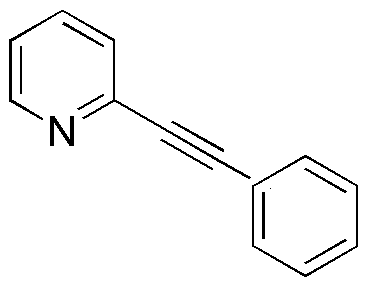2-(Phenylethynyl)pyridine is widely utilized in research focused on:
- Organic Synthesis: This compound serves as a versatile building block in the synthesis of complex organic molecules, making it valuable for chemists developing new pharmaceuticals and agrochemicals.
- Material Science: It is used in the development of advanced materials, particularly in creating polymers with enhanced properties, such as improved thermal stability and mechanical strength.
- Fluorescent Probes: The compound acts as a fluorescent probe in biological research, allowing scientists to visualize cellular processes and track biomolecules in real-time.
- Ligand Development: In coordination chemistry, it functions as a ligand in metal complexes, which can be applied in catalysis and sensor technology, offering improved selectivity and efficiency.
- Drug Discovery: Its unique structure contributes to the design of novel drug candidates, particularly in targeting specific biological pathways, thus enhancing therapeutic efficacy.
Informations générales
Propriétés
Sécurité et réglementation
Applications
2-(Phenylethynyl)pyridine is widely utilized in research focused on:
- Organic Synthesis: This compound serves as a versatile building block in the synthesis of complex organic molecules, making it valuable for chemists developing new pharmaceuticals and agrochemicals.
- Material Science: It is used in the development of advanced materials, particularly in creating polymers with enhanced properties, such as improved thermal stability and mechanical strength.
- Fluorescent Probes: The compound acts as a fluorescent probe in biological research, allowing scientists to visualize cellular processes and track biomolecules in real-time.
- Ligand Development: In coordination chemistry, it functions as a ligand in metal complexes, which can be applied in catalysis and sensor technology, offering improved selectivity and efficiency.
- Drug Discovery: Its unique structure contributes to the design of novel drug candidates, particularly in targeting specific biological pathways, thus enhancing therapeutic efficacy.
Documents
Fiches de données de sécurité (FDS)
La FDS fournit des informations de sécurité complètes sur la manipulation, le stockage et l’élimination du produit.
Spécifications du produit (PS)
Le PS fournit une description complète des propriétés du produit, notamment sa composition chimique, son état physique, sa pureté et les exigences de stockage. Il détaille également les plages de qualité acceptables et les applications prévues du produit.
Certificats d'analyse (COA)
Recherchez des certificats d'analyse (COA) en saisissant le numéro de lot du produit. Les numéros de lot et de lot se trouvent sur l'étiquette d'un produit, après les mots « Lot » ou « Lot de fabrication ».
Numéro de catalogue
Numéro de lot/série
Certificats d'origine (COO)
Ce certificat d'exploitation confirme le pays dans lequel le produit a été fabriqué, et détaille également les matériaux et composants utilisés et s'il est issu de sources naturelles, synthétiques ou autres sources spécifiques. Ce certificat peut être requis pour les douanes, le commerce et la conformité réglementaire.
Numéro de catalogue
Numéro de lot/série
Fiches de données de sécurité (FDS)
La FDS fournit des informations de sécurité complètes sur la manipulation, le stockage et l’élimination du produit.
DownloadSpécifications du produit (PS)
Le PS fournit une description complète des propriétés du produit, notamment sa composition chimique, son état physique, sa pureté et les exigences de stockage. Il détaille également les plages de qualité acceptables et les applications prévues du produit.
DownloadCertificats d'analyse (COA)
Recherchez des certificats d'analyse (COA) en saisissant le numéro de lot du produit. Les numéros de lot et de lot se trouvent sur l'étiquette d'un produit, après les mots « Lot » ou « Lot de fabrication ».
Numéro de catalogue
Numéro de lot/série
Certificats d'origine (COO)
Ce certificat d'exploitation confirme le pays dans lequel le produit a été fabriqué, et détaille également les matériaux et composants utilisés et s'il est issu de sources naturelles, synthétiques ou autres sources spécifiques. Ce certificat peut être requis pour les douanes, le commerce et la conformité réglementaire.


